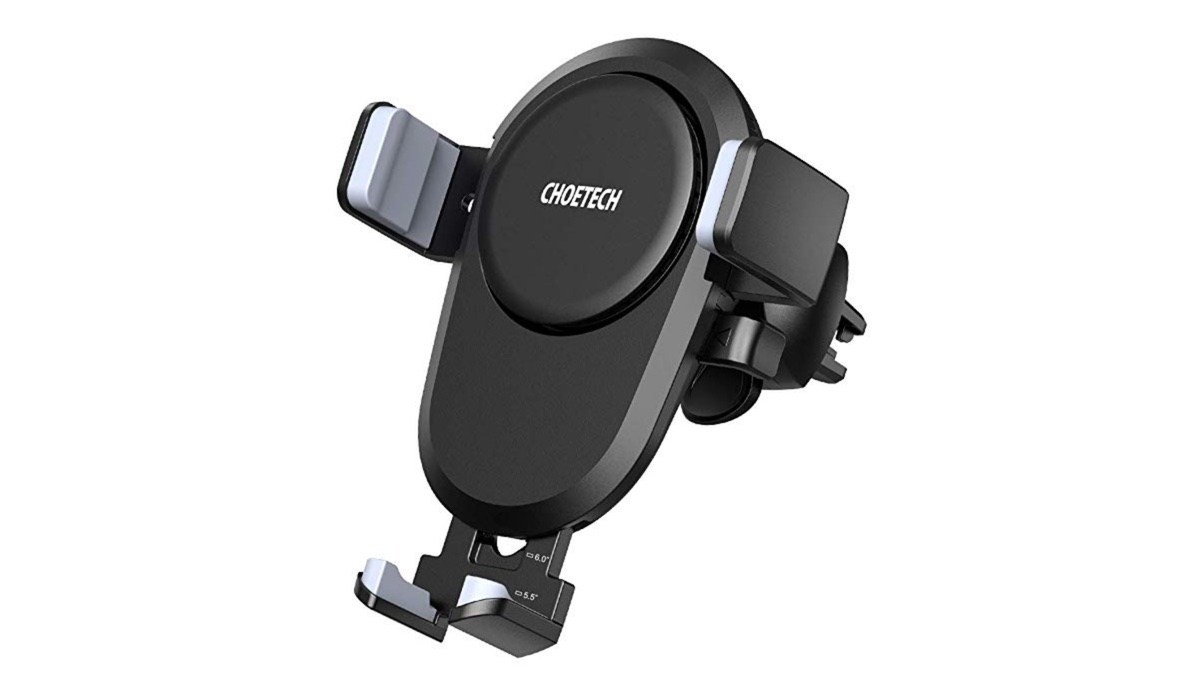
Batman Doomsday is this week’s evil Metal entry in the Dark Knights: Metal crossover event but the best stories are the debut issues of Black Lighting: Cold Dead Hands #1, and The Jetsons. Yes, The Jetsons.
Plus, Betty and Veronica and Harley and Ivy do a life switch in Harley & Ivy Meet Betty & Veronica #2; Bruce and Selina invade Talia’s sanctum in Batman #34; Deathstroke is forced to confront his evil choices in Deathstroke #25; while Nightwing calls Raptor out in Nightwing #32. Plus, reviews of all of this week’s DC Comics.
To read reviews from past weeks, check out our index, sorted by date.
Spotlight Issues:
Black Lightning: Cold Dead Hands #1 – Tony Isabella, Writer; Clayton Henry, Artist; Pete Pantazis, Colorist
Ray – 8/10
Corrina: About Time For Jefferson Pierce
Ray: With the CW’s new take on Black Lightning coming in January, DC was smart enough to get the original creator back on a new miniseries to revitalize the character and make sure fans remember DC’s groundbreaking African-American hero. The good news is, it’s like Isabella never left, as he’s one of those writers (like Marv Wolfman or Gerry Conway) whose writing style updated nicely with the times. The bad news is, he’s still stuck with the young Black Lightning of the New 52, instead of the mature dad the series was based on. Still, this issue makes the most of the status quo, picking up with Jefferson Pierce returning to Cleveland to say goodbye to his father, after the renowned journalist passes on. His main adversaries this issue are a gang of thieves wielding high-tech guns, called the Weathermen – and, of course, the Cleveland police force.
The scenes with the police are maybe a bit too on-the-nose – they feel more like the trigger-happy Marvel police who are constantly shooting at Spider-man than actual rogue police – but the real show-stealer in this issue is main villain Tobias Whale. He replaces the original grotesque version introduced by Frank Tieri, in a hasty retcon that likely pulls the character more in line with what he’s going to be like in the series. His introduction scene is brutal, and his puppet-mastering over the course of the issue makes him very reminiscent of Michael Clarke Duncan’s Kingpin. But the real strength of this issue is Isabella’s practiced hand with Jefferson and his world, making him a much more down-to-earth hero than most DC characters. This is a miniseries worth watching as it moves forward.
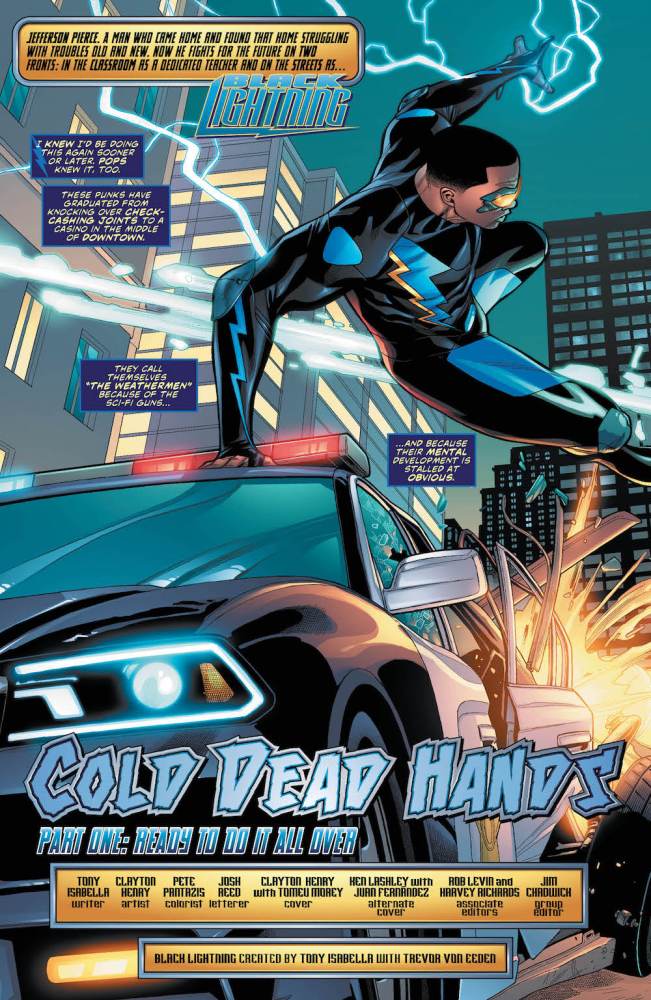
Corrina: I bought the first issue of Black Lightning off the spinner rack oh-so-many-years ago and instantly bonded to Jefferson Pierce. I loved everything about the character, as that origin issue established what you needed to know about Pierce: a Olympic athelete. A principled man out to protect those in his neighborhood and someone who took on the disguise in order to protect his students from being caught in the crossfire.
Since the 1970s, Isabella was involved in a protracted feud with DC about the use of Black Lighting–indeed, Black Vulcan was substituted for Black Lightning in the 70s Superfriends show. There is also some controversy about artist Trevor von Eeden’s role in Pierce’s creation. All this may have kept Pierce from being spotlighted in only fits and starts in the comics over the years but it’s terrific to see him back now and being written by his creator.
Isabella is working with a younger Pierce, a hero approximately the same age as in his origin issue, rather than the older character with grown children that developed over the years in the comics. Perhaps that’s why the character seems so solid and well-developed in this story–Isabella knows exactly who this Pierce in this stage of his life is, despite the change of scenery to Cleveland (instead of Metropolis) and despite the presence of Pierce’s father, who wasn’t in the original conception of the character.
What does this mean for the reader? A chance to get to know Jefferson Pierce and bond to him, as I did all those years ago. A fine return to the character for Isabella and excellent artwork by Clayton Henry for the story.
The Jetsons #1 – Jimmy Palmiotti, Writer; Pier Brito, Artist; Alex Sinclair, Colorist
Ray – 9.5/10
Corrina: Realistic (Sorta) Jetsons
Ray: The Hanna-Barbera line has been a mixed bag of fascinating ideas and poor execution since the start, but this new futuristic, Black Mirror-inspired take on the family of the future is one of the best things they’ve done yet. Palmiotti, writing solo for a change, picks up right where he left off from his backup in the crossover special, and now gets the chance to explore the full world. And it’s both brighter and darker than we expected. The issue picks up with the family getting used to their new status quo with George’s mother now in the immortal body of “Rosie”, and everyone going about their business. George’s terrible job for Mr. Spacely now has the added wrinkle of him being the last man doing an obsolete job, making him indispensable and overworked. Judy is basically still the same but seems to be a bit more complex and ambitious now.
The other two members of the Jetsons, though, are where this issue shines. Jane is no longer a housewife, but now a brilliant scientist in her own right, and at the vanguard of a coming crisis for Earth. Elroy, meanwhile, has been aged up to preteen and has an adventurer’s streak and a fellow explorer girlfriend, and their dive into the ocean under the floating city leads to the issue’s first wild reveal. Pier Brito manages to whiplash cleanly from bright and colorful to stark and terrifying, and this issue’s utopian future hides some horrible skeletons. There’s a great segment about the potential pitfalls of transcending the human body between George and Rosie, and this issue does an amazing job of fleshing out the family dynamic and leaving a lot more to explore. This is one of the most promising debuts I’ve read from DC in a while.

Corrina: While the cartoon was enjoyable, mainly for the one-liners and ridiculous schemes, the Jetsons as a family were always two-dimensional and stereotypical. (Apparently, even in the future, women didn’t have careers.) Unlike some of the other HB properties, such as Scooby-Do, which still work fine in its original form, the futuristic Jetsons suffered from being, well, dated.
This issue takes care of that problem, taking the 1950s idea of a nuclear family with some generic space trappings, and creating a real world around a core family that fits the setting. The initial idea of Rose being Grandma seemed off-beat but it’s just the kind of weird that one expects in good SF. And George taking care of obsolete tech is a terrific idea and it’s grand to see Jane as a scientist. But none of these transformations work unless the story also works and it does because it seems Elroy and his friend have awakened a serious problem, one that opens this story world to a wider scope. Terrific origin issue and it would be terrific even if it was from an original idea, rather than an old cartoon.
Near Perfect: Ratings 9-10
Batman #34 – Tom King, Writer; Joelle Jones, Artist; Jordie Bellaire, Colorist
Ray – 9.5/10
Corrina: Motivation Is Better
Ray: Another excellent issue from King and new art team member Joelle Jones, as we learn more about the motivations of Batman and Catwoman’s mysterious trip into the desert, and Tom King proves that for all the darkness, mystery, and horror of his run at times, his strength may be dialogue and…comedy? The issue opens with Batman and Catwoman in the desert, surrounded by an army of deadly, voiceless ninjas. Their banter here is more like an old married couple than anything, and based on this alone I want this new status quo to last forever. Meanwhile, Talia Al Ghul watches everything, getting ready to make her move. I’m sure a lot of Batman and Robin fans will be thrilled to see Dick and Damian working together again as well – their Batman and Robin dynamic from the Morrison era is 100% on point.
Superman appears in this issue as well, serving as a guard to keep Dick and Damian out of the forbidden zone when they show up to try to help Batman. Can I just say how much I love King’s Superman? A pint-sized ninja threatens to summon a demon to kill him, and his response is “But then my son would be mad at you”. Isn’t that just the most Superman thing ever? The question last issue was why Batman would bring his new fiancee into the desert to confront his ex, but they’re not there for him – they’re there for Selina’s protege and friend, Holly, who was revealed to be a killer earlier in the run and has apparently run off to Talia’s lair. It’s a great saving throw that makes Batman look like much less of a screw-up. The final showdown between Talia and Selina is telegraphed, but it’s the dialogue in this issue that makes it shine. I’d read a crossover by King, Tynion, Bennett, Snyder, Seeley, and Tomasi that was just a Bat-family dinner. Get on that, DC!

Corrina: I could go for a Damian/Superman team-up someday, as seen in this issue. I like the banter between Bruce and Selina as well, especially how easily they trust each other. But while the motivation for invading the sanctum of Bruce’s baby mama makes more sense this issue, I’m still not buying it. Presumably, Holly is needed to prove Selina innocent of mass murder? But given that the world is going down the toilet in Metal, wouldn’t it be easier to get a pardon from the President for helping to save the world again, especially if Batman can present evidence that Selina’s innocent?
But, of course, then we wouldn’t have this issue and the big fight sequences drawn by Jones, which are spectacular. (Though, hey, Selina, pulling that sword out of Bruce will do him more damage!). I haven’t fully bought into on this arc, not because of the engagement, but because of the circumstances around it, but this is an improvement over the last issue
Very Good Issues: Ratings 8-9
Deathstroke #25 – Priest, Writer; Carlo Pagulayan, Penciller; Norm Rapmund, Trevor Scott, Jason Paz, Inkers; Jeromy Cox, Colorist
Ray – 8.5/10
Corrina: Can Evil Men Change?
Ray: Deathstroke reaches its 25th issue, with Priest having stayed on for the entire run (much longer than many people were predicting, given DC’s past issues with holding on to talent). While this 25th issue is a very solid read, it’s also a bit of an oddball comic that’s sort of out of step with the rest of the run. Instead of focusing on Deathstroke’s family drama and Machiavellian hidden agenda, this issue finds him and his new turn for the heroic put on trial by his former allies in the Secret Society of Supervillains. The “jury” consists of Vandal Savage, Riddler, Hector Hammond, Ultra-Humanite, Raptor, Black Manta, Reverse Flash, Killer Frost (who is there reluctantly, given her own heroic turn) and Deathstroke’s recent victim Deadline. They’re all skeptical about Deathstroke’s heel-face turn and want to put him to the test.
The issue whiplashes between Deathstroke’s trial, and his past, which is shown in flashbacks and involves an abusive father of his own, an early enlistment in the military and a ruthless military career. Although the banter between the villains is entertaining, they seem more like a sideshow to the title, and most of Deathstroke’s big anniversary issue being taken up by guest-starring villains seems a bit odd. Deathstroke’s family and partners are limited to some brief framing segments. What does work, though, is the depiction of exactly how easily Deathstroke would take out some of these ruthless, more powerful villains thanks to his suit and extremely high-level training. This issue is, more than anything, a spotlight for just how deadly Deathstroke can be, and while it’s not the series’ best issue, it’s definitely another strong one in a streak of 25.

Corrina: The villains, to me, were just Slade’s psyche talking to him, making a case for the fact that while he wants to change, he cannot alter his essential nature toward destruction. His whole arc under Priest has been, at first, Slade trying to emotionally connect with people and failing because, hey, his idea of bonding with Rose is creating a fake family for her, or bonding with Joe by creating a superteam that Slade then bosses around. World’s Worst Father, indeed, though Priest’s alternation to this has been an Adelaide that is as ruthless as her ex-husband. (A hit on Rose? Really?)
Seeing Slade essentially have a talk with himself, allowing the reader to see his abusive childhood–Slade must think his ‘fathering’ of his kids was better–humanizes him, showing that the seeds of his inability to connect with people were forged long ago. People don’t become ruthless mercenaries without reason and while not every abused child becomes Deathstroke, it might be accurate to say that only a child who had empathy driven out of him would become Deathstroke.
And, yes, for once, Slade beating up uber-powerful villains works because of the advantage of the IKON suit.
Green Lanterns #34 – Tim Seeley, Writer; Ronan Cliquet, Artist; Hi-Fi, Colorist
Ray – 8.5/10
Ray: After some slight first-issue growing pains on the new creative team, Seeley settles into his groove and delivers a very strong second issue with good spotlights for both of Earth’s newest Lanterns. As the issue opens, Jessica is busy trying to stop the Molites from committing collective suicide on their soon-to-explode planet, while Simon is on board the Ungaran shuttle in the aftermath of a disaster that has left the daughter of the captain near-death. This segment does a great job of showing off their unique skills – Simon’s healing abilities, which are still a mystery, and Jessica’s compassion. Jessica’s method for getting the Moloids off-planet is a bit hokey, but that’s lampshaded in story and kind of shows her inherent optimism. Meanwhile, there are some interesting details revealed about Liseth, and it seems she might be sticking around.
On Earth, though, things are less shiny for the Lanterns. Jessica gets the job she was applying for, but the owner is skeptical about her because of her anxiety and decides to start her off behind the scenes rather than as waitstaff. Meanwhile, Simon doesn’t get the job because of his past. Seeley seems to be interested in focusing on the hardships they’ll face because of their skin color and disabilities, but this scene was a bit of a problem – no employer will actually tell an interviewee that they won’t get the job because of their religion or ethnicity. That would be an immediate lawsuit – they just wouldn’t call back. Simon’s decision to move off-world to “his own place” in a space station is interesting, though – that’s one way to get some distance from the family! The voices are similar enough that this run is quickly finding its own groove, and remaining one of DC’s strongest titles.
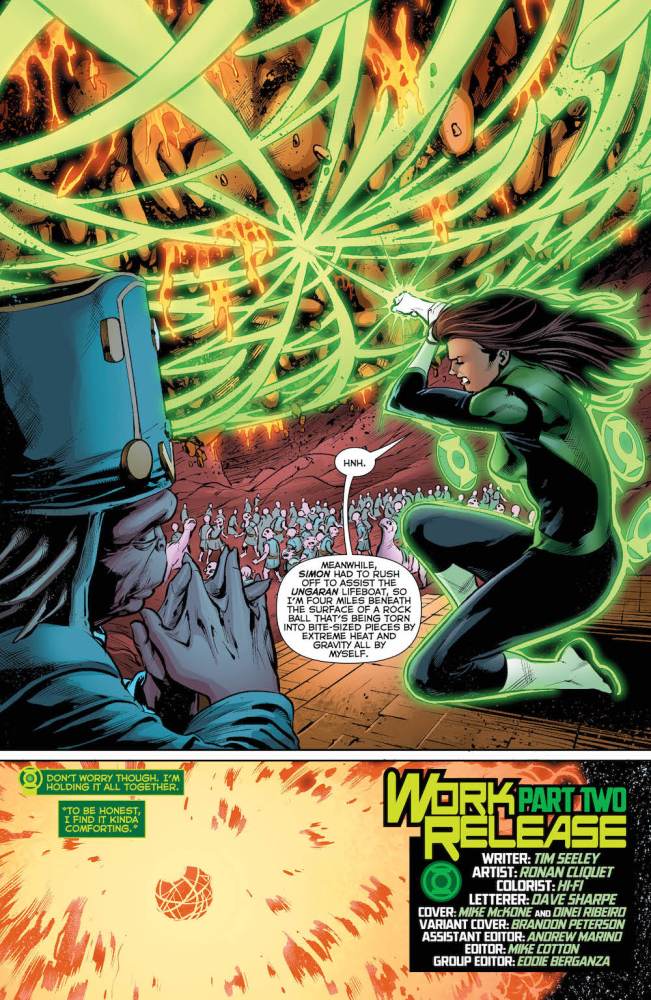
Corrina: I suspect that telling Jessica that they’re limiting her employment opportunities because of her anxiety might also be a violation of the Disabilities Act. Though Jessica did disclose it, so that might make a difference. Still, a barista seems an odd choice for her. Jessica is good with children and other people, as we see from her action sequences. I would have rather seen her do work ala Meals on Wheels or hospital volunteering or something where she’d be helping people in another way, as efforts in that direction seem to soothe her anxiety.
Still, the space-based sequences are terrific, with Jessica finding a way to reach the Moloids and Simon staving off disaster for those who came to help. It seems like Liseth will be a continuing character, given the attention paid to her introduction. I’m curious about where this is going.
Superman #34 – Peter J. Tomasi, Patrick Gleason, Writers; Ed Benes, Doug Mahnke, Jack Herbert, Artists; Dinei Ribeiro, Colorist
Ray – 8.5/10
Corrina: Lois as Female Fury
Ray: This issue’s divided the main characters on Apokalips, with everyone out of their element. The issue opens with Lex Luthor returning to his loyal subjects, who have been waiting for their new God to take his throne. There’s a twist, though – Luthor is ready to abdicate, proving that he can’t be the true figure in the prophecy. The group of Apokaliptans are ready to tear him apart for lying to them, but as always, Luthor’s got one more trick up his sleeve, as he presents to them the man he claims is the real source of the prophecy – Superman, who is more than a little confused as to why he’s here. Jon has very little to do this issue, being on his own in the hostile environment and running from giant dog-monsters and soldiers. But neither he nor Superman are the actual stars of the issue.
That would go to Lois Lane, who finds herself alone and quickly captured by Granny Goodness and the Female Furies. At first, she’s a slave and treated brutally by the more sadistic members of the Furies. But when they come under attack from a Dredge Worm like something right out of Tremors, Lois’ military experience comes in handy, and she winds up winning the respect of her captors. When one of the Furies is killed in battle, Lois is gifted her armor and ends up an honorary member of the Furies. This segment has a fun, engaging Mad Max vibe to it, and it’s good to see Lois in this hostile environment actually winding up being the most comfortable of the family. The characterization of Granny Goodness is a bit all over the place, especially considering the events of Mister Miracle, but as a spotlight for the Superfamily and Lois in particular, this issue hits the mark.
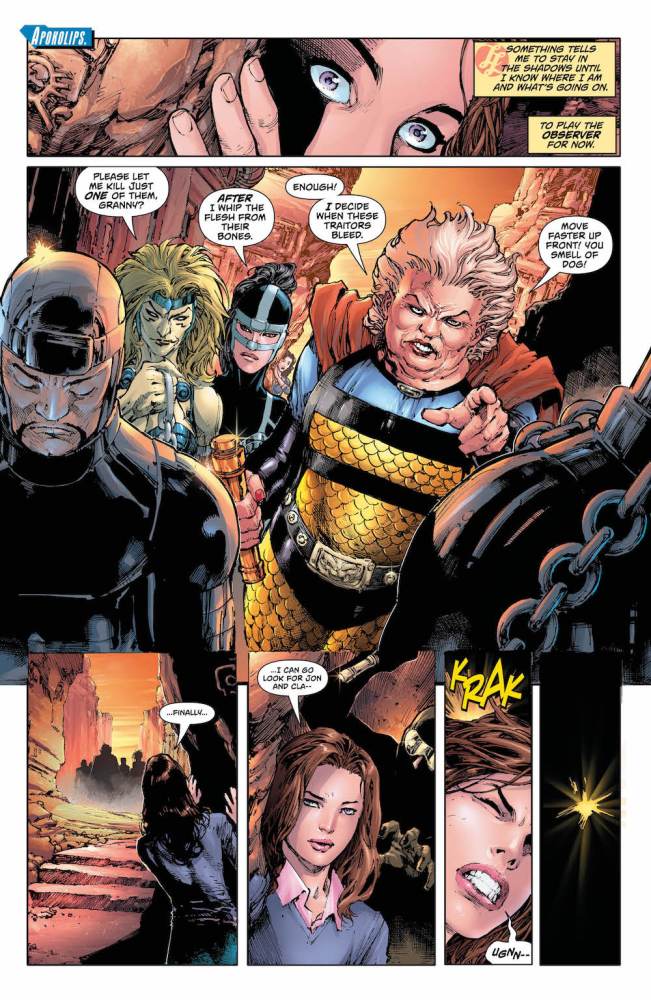
Corrina: So, for once, Lois is allowed to rescue herself. That’s nice. Let’s see more of that.
As to the overall plot, this is another leftover plot from a while back, with Luthor supposedly as the replacement for Darkseid. It won’t last long, as we know baby Darkseid is now Teen Darkseid and I would expect him to take control again as I can’t remember the last time DC allowed a true change in the villain status quo. That leaves me somewhat disinterested in the concept of this arc but I like the glimpses of Apokaliptan culture, even if it does conflict with Mister Miracle.
Justice League #32 – Robert Venditti, Writer; Liam Sharp, Artist; Adam Brown, Colorist
Ray – 8.5/10
Corrina: So…Virtual Batcaves?
Ray: Robert Venditti takes over for the remaining three parts of “Bats out of Hell”, with the incomparably detailed Liam Sharp (previously of Wonder Woman) on art for this issue, and it’s a non-stop thrill ride that I found to be one of the most entertaining tie-ins yet. This issue picks up as the Justice League has been separated into deadly Batcaves specifically designed to target their weaknesses. The first up is Flash, who goes up against the Red Death in a high-speed chase. It’s all sort of ridiculous, but the quicksand environment and the incredibly creepy design of the evil “Flashmobile” really work. Meanwhile, the Drowned may be the weakest of the evil Batmen, but no one draws monsters like Liam Sharp, and the segment where the sics a giant monster crab on Aquaman is gorgeous.
Wonder Woman’s segment has the least pyrotechnics of the three, as neither side has any monsters or accessories to show off. Rather it’s a bit, mythologically driven fight as Wonder Woman faces off against her friend, corrupted by Ares. This being Metal, of course, there’s a horror-driven twist where we find out what happened to the Amazons of the Merciless’ world. The source of these Batcaves, and who is creating them and why, is a great last-page twist, and Venditti saves the most interesting Dark Knight – the Dawnbreaker – for next issue’s spotlight with Hal Jordan in his title. Even if the story isn’t essential reading, Sharp’s art makes this a must-buy.

Corrina: I cannot argue with the brilliance of Sharp’s art. I like the overall narration from Cyborg. And if single members of the Justice League fighting various evil Batman with powers that match up to them is your jam, go for it.
But, obviously, these are virtual Batcaves that will have to be disconnected, as Cyborg will have to be as well.
Green Arrow #34 – Benjamin Percy, Writer; Stephen Byrne, Artist
Ray – 8/10
Corrina: Ollie Is Keeping Secrets Again
Ray: Stephen Byrne, hot off the recent Justice League/Power Rangers crossover, returns to Green Arrow and delivers a fantastic-looking issue. As always, this book’s star is its unique and vivid art, but the story holds its own as well. This issue is primarily one about reunions, starting with the massive one of Oliver and his mother Moira – who is now working for and trying to subvert the current leadership of the Ninth Circle. Obviously, this story has to draw some comparisons to another tale involving a superhero and a presumed-dead parent turning out to be potentially evil, but while I don’t think Moira is given quite as many layers as the fascinating Jor-El, her opposite perspective from her very liberal son makes for a compelling angle.
Percy’s bringing back the political elements to Green Arrow in a big way, and while the Ninth Circle represents cartoonish plutocrat evil, Moira is a slightly different breed – she believes the system can be reformed from within, something that Ollie is deeply skeptical of. However, he’s talked into forming an alliance with his mother to take on the current leadership of the Circle. While this segment is strong, it felt like most other characters took a backseat. There’s some more of the backstory for Diggle and Malcolm Merlyn, and Diggle deserves a better plot than this. Meanwhile, Emiko is limited to one scene, and Dinah mainly drops in in between Ollie’s other plots. It looks great, but as the series goes to monthly with this issue, it feels like the story could be moving a bit faster.

Corrina: Moira is a nice addition to the cast and, for me, works better than Jor-El, as her motives are more complex, all tied in with power and love and choices. The main problem with the Ninth Circle is that they’ve been cartoonish villains, as Ray said, and Moira promises to be more than that. Still, it would be nice if Oliver would inform his allies what he’s doing, considering how they’ve helped and what they’ve done for him.
Diggle’s plot with Merlyn struck me as somewhat off but I guess they wanted to use two characters from the television show?
As for the art, I thought nothing could match Otto Schmidt by Byrne is similarly amazing. Ollie’s never looked so pretty. Too bad he’s still being kinda a jerk.
Nightwing #32 – Tim Seeley, Writer; Scot Eaton, Miguel Mendonca, Pencillers; Wayne Faucher, Diana Egea, Inkers; Chris Sotomayor, Colorist
Ray – 8/10
Corrina: Nightwing vs. Rapture–But Not In Battle
Ray: It’s Seeley’s penultimate issue of Nightwing, and for this one, he wisely pulls back and makes the issue essentially a showpiece for Nightwing and his new nemesis Raptor. When we last left off, Raptor had tracked Dick down at his job at the casino, essentially trapping him in a situation where Dick can’t escape or fight back without revealing himself to Blockbuster. From there, the issue is as much of a battle of wills as anything, as the two men tied by that one tragic night at the circus try to get under each other’s skin. Raptor plays his most powerful card, taunting Dick as a betrayer of his family’s legacy and trying to provoke him into a fight while believing he’s exposing Bludhaven as hopelessly corrupt. However, Dick isn’t baited so easily.
Dick is the first trainee of the greatest detective in the world, after all, and he’s had plenty of time to analyze Raptor and figure out his behavior. He manages to perfectly pick out the truth of what happened on that night – and why Raptor, Mary’s self-proclaimed protector, wasn’t there to save her. Exposing Raptor as a coward is the best way to get under his skin, and that causes him to make his move – triggering a Blockbuster virus that surrounds Dick with dozens of civilians turned into transforming hulks. These segments work really well, but all the others – involving Defacer, the band of former villains, and Orca – don’t really work, and feel more like a distraction than anything else. But a run that introduces an iconic new arch-nemesis for its hero is already successful in the big ways.

Corrina: This feels like an ending for any rapprochement between Dick and Raptor because Dick correctly calls out Raptor for his cowardice and his version of the “truth.” For all his high rhetoric, Raptor is all about proving that he never did anything wrong, failing to face his past, and Dick and everyone else for the way the world is. Looks like the talking is over for good.
Unlike Ray,I liked the bits with the reformed villains, as I think they’ve been Seeley’s most interesting and inventive addition to Nightwing’s supporting cast. He’s even managed to create something of a sad and sympathetic figure in Orca. We’ll see if they’re key to saving their own city. I suspect they will be.
Injustice 2 #13 – Tom Taylor, Writer; Mike S. Miller, Artist; J. Nanjan, Colorist
Ray – 8.5/10
Ray: This issue pulls back from the action-packed apocalypse of the last few issues to tell a rather intimate, well-written story featuring only three characters – Supergirl, Black Adam, and Damian Wayne. Since we last left Kara, she’s been kept in Khandaq under the watchful eye of Black Adam, who has been teaching her to use her powers while still protectively keeping her confined to the territory. However, as she goes through growing pains in learning to fly, there’s a new wrinkle as Damian comes to Khandaq seeking to recruit Adam for his help in the coming war, as Ra’s Al Ghul’s plans to wipe out a large chunk of the world’s population pick up steam. Adam is hostile to Damian, not willing to leave his territory – but Damian picks up a glimpse of Adam’s secret houseguest and sets a plan into motion.
The interesting thing about this issue is that this story could be sweet – it’s essentially about two teenagers, one still grieving her world and the other dealing with a deeply unhealthy relationship with his father, bonding and learning about the world. But this is the Injustice world, and there’s a sinister sheen over everything. Damian is not a nice kid in this world. He’s deeply manipulative and was a key part of Superman’s brutal regime. Maybe his kindness towards Supergirl is genuine, or maybe he simply wants to use her. And his plan to free Wonder Woman (probably the weakest character in this series, due to how one-note she was) is definitely not going to make the world a better place. But this issue really drives home just how strong Taylor’s hand with dialogue is.
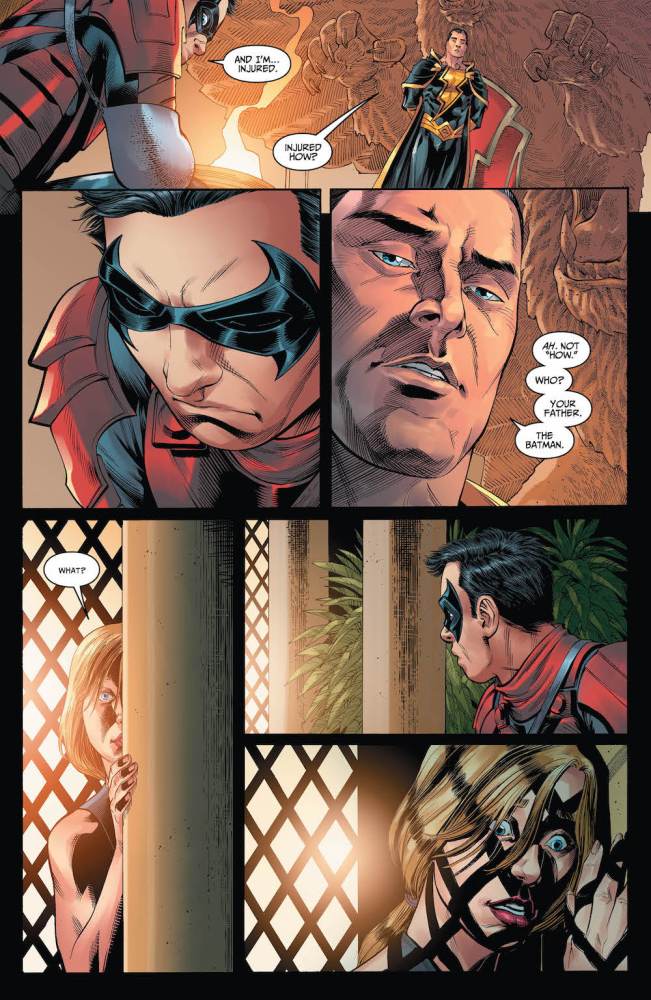
Good Issues: Ratings 7-8
Batman: White Knight – Sean Murphy, Writer/Artist; Matt Hollingsworth, Colorist
Ray – 7.5/10
Corrina: Joker–from Chaotic Evil to Lawful…Evil?
Ray: As Sean Murphy’s political, charged tale of the Joker’s reform and Batman’s unraveling continues, this issue has some major twists that completely change what we think of this story. As the issue opens, Jack Napier makes his case for his freedom, casting himself as a victim of Batman and the media, and tying himself in with the disenfranchised of Gotham. It’s an interesting angle, but are we really supposed to buy that so many people would side with a killer clown over their protector? And the “Batman doesn’t protect people in the poor areas of Gotham” thing doesn’t really wash. However, the twist involving Harley – explaining why she’s acted so brittle and clingy in this issue – is great, and this is probably the best take on her and Joker’s relationship since Paul Dini said his last word on the characters. It’s unhealthy, but you can see why it works.
Batman is almost a side character in this issue, left off to the side to deal with a subplot involving Mr. Freeze and his attempts to resurrect Alfred. Every scene Murphy draws is brilliant, but there are some characterization glitches with the heroes – particularly Batgirl, who acts like a hyper girly-girl, cooing over cute mice and overall acting even younger than she did in Burnside. Joker is by far the most fascinating character in this story, which is rare, but he comes off as a tragic, obsessed figure whose fixation with Batman has destroyed him, and now he’s seeing things clearly for the first time. Which makes the whiplash at the end of the issue rather odd, as he unveils a detailed revenge plot involving the Rogues of Gotham that makes clear he’s still a villain – just a much smarter one. The story looks great, but as a story, I’m not 100% sold yet.
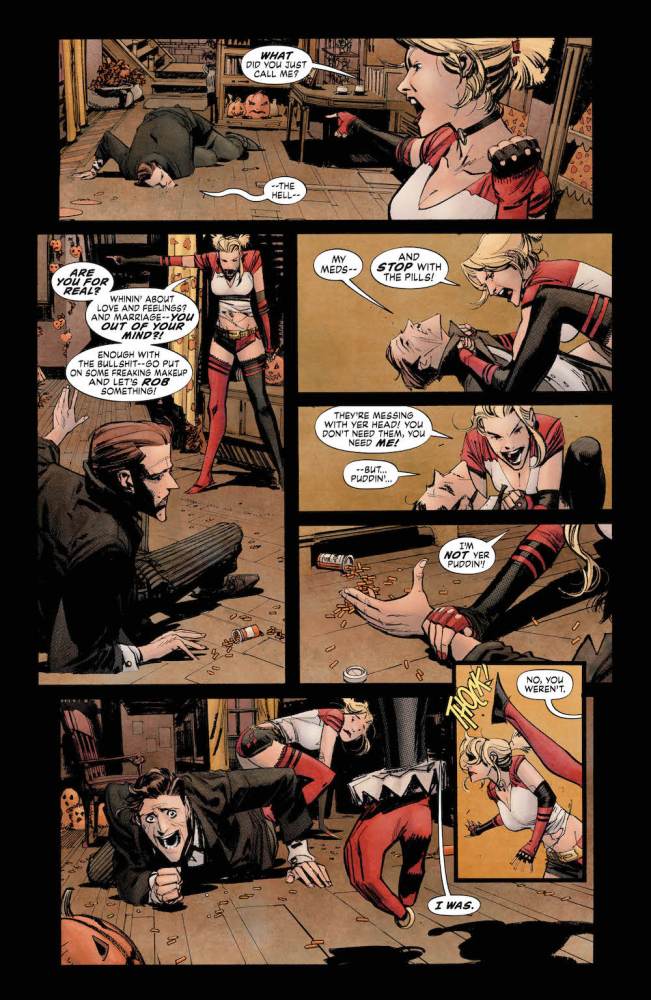
Corrina: The mood created by Murphy’s artwork captures Gotham as its most dangerous and his twist reveal with Harley Quinn indeed resets things with that relationship nicely in this world.
However, this remains an alternate world Joker story. And we all know how much I dislike Joker stories. Which means if Joker is the most fascinating thing in the story, as Ray says, then I’m not interested.
Batman: The Dark Prince Charming Book One – Enrico Marini, Writer/Artist
Ray – 8/10
Ray: There’s a lot of unusual things about this small graphic novel, which is actually part one of two. The second part will be released in early 2018. First up, it’s essentially the size of about three regular comics, but it’s being released in hardcover format. But honestly, 60 pages for $12.99 isn’t a bad buy given the average price of comics. Second, it’s the American debut of Italian comics legend Enrico Marini, best known for works with European writers including “Le Scorpion”. But really, the oddest thing about this issue is how normal it feels. This is essentially a fairly standard Batman miniseries told in OGN format, with uniquely gorgeous art and a fairly standard plot involving that most iconic of Batman villains – the Joker.
There’s two main subplots in this issue. The first, and most effective one involves Batman’s arch-nemesis. What starts as a fairly standard plot involving a Joker heist and Harley’s birthday devolves into a genuinely epic car chase and a massacre at Joker’s lair. (He’s not supposed to be the main character, but Archie, Joker’s harried dwarf henchman, is hilarious). Less interesting is a plot involving a woman claiming to have a daughter with Bruce Wayne, and Bruce’s characterization in this segment seems a bit off. No mention of Robins or any other Bat-kids, so I’m guessing Marini is basing this off something resembling the Nolanverse.
These two subplots come together in the framing segment, where Joker has kidnapped the little girl and placed her in his dungeon, where he torments her in a creepy, playful manner that makes him seem less like Snyder’s deranged sadist and more like a twisted childish clown. The issue does have some interesting takes on villains, between this take on the Joker and a Killer Croc who feels more like a gang leader than a swamp mutant. This OGN is worth a buy for the gorgeous art, especially in the opening chase segment, and some genuinely creepy segments, although its weakest point, oddly, may be Batman himself.
The Shadow/Batman #2 – Steve Orlando, Writer; Giovanni Timpano, Artist; Flavio Dispenza, Colorist
Ray – 7.5/10
Ray: The second issue of Steve Orlando’s follow-up to Batman/The Shadow continues to expand the mythology of the Shadow and his complex alliance with Batman, but the emphasis here seems to be as much if not more so on Batman’s relationship with his son – and that’s where the issue is at its weakest, unfortunately. Damian’s belligerence and mistrust of Bruce seems out of step with what we’ve seen of the two of them for the last few years, much more in line with the early years of the character. When those two are arguing, the issue barely holds my interest, but when Shadow shows up – all intimidation and barely contained insanity – Orlando is in his element once again. Orlando channels the pulp roots of the Shadow more than the full-on horror vibe he had with Snyder in the last mini, but it still works.
The Shadow in this series is not in a good place. After losing his chance to be free of his curse at the end of the last miniseries, and bidding farewell to Margo Lane (who died of old age) at the start of this one, his relationship with Batman is distinctly more antagonistic at first. However, once they get to talking, it becomes clear that another adventure is waiting, this one uniting two of their deadliest enemies – Ra’s Al Ghul and Shiwan Khan, the evil descendant of Genghis Khan. This miniseries seems like it’s going to be much more of an old-school swashbuckling adventure, which is more of the Shadow’s classic groove, but overall this is sort of lacking an antagonist nearly as dynamic as The Stag, and doesn’t seem to be building the mythology of the previous run. Orlando’s writing is solid, but not every event needs a sequel.
Bombshells United #5 – Marguerite Bennett, Writer; Siya Oum, Marcelo DiChiara, Artists; J. Nanjan, Colorist
Ray – 7.5/10
Corrina: Wonder Women
Ray: The first arc of Bombshells United wraps up with a strong if slightly confused finish, as this arc has gotten into a lot more mysticism and spiritual elements in its plot, viewing the Wonder Woman legacy in an almost religious fashion. The first segment is the final showdown with General Ulysses Armstrong and his Clay army, as the reformed Clayface joins forces with the Wonder Girls. Siya Oum, who I believe is a DC artist’s workshop graduate, does a good job of capturing the chaotic nature of the battle and Bennett lets all the Wonder Girls have a chance to shine. It still feels like there’s a few of them besides Donna and Cassie that we have yet to get to know, but we’ll get there. The resolution feels a bit pat, but it’s good to get to see Donna’s family in the middle of all this.
The second story, I thought, was the weaker of the two, as Donna and Dawnstar meet in the aftermath of the battle as Donna struggles to deal with the death of her friend and mentor. Wonder Woman’s “Death” earlier in this arc is probably the biggest weak spot of this series so far, as it happened very abruptly and didn’t seem like something that would actually kill a powerful figure like Diana. The revelation that Donna now has the ability to summon Diana via a magical process is good in that it brings Diana back into the picture, although it’s not explained as much as I would have liked. What’s more, I feel like this type of plot would have been better used with the gone-too-soon Stargirl.
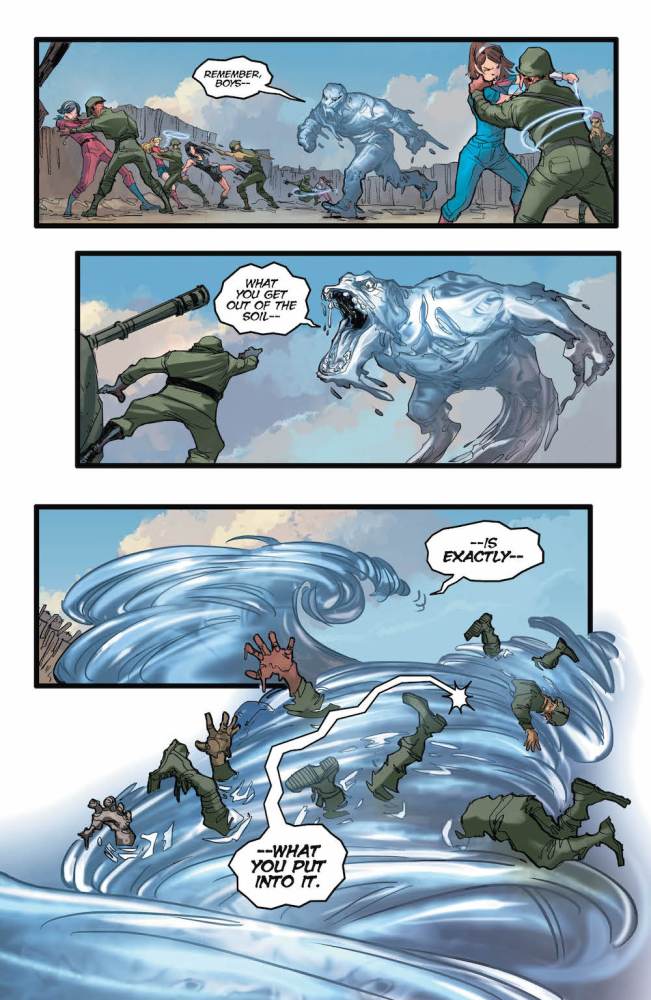
Corrina: This series sometimes packs so many ideas into a single issue that it’s hard to know where to focus. The good side is that the concepts are fantastic and I want more of each. The bad side is that the story itself can suffer from the lack of focus. For instance, the final showdown with Armstrong and the Clay army is great but, as Ray points out, some of the new Wonder Girls are lost in the shuffle, never becoming distinct characters. (But I want more of them.)
Diana’s “rebirth” so quickly is good to see but, as with the first story, the concept is not fully explored so it can feel truncated. Still, Bennett throws out more interesting ideas and characters per page than any writer in the DCU.
Harley and Ivy Meet Betty and Veronica #2 – Paul Dini, Mark Andreyko, Writers; Laura Braga, Artist; Arif Prianto, Colorist
Ray – 7.5/10
Corrina: Good Times Ahead
Ray: Two issues in, it’s clear this is going to be the craziest crossover DC has ever done, a bout of collective insanity that hasn’t been seen in comics since…well, the last time Archie characters crossed over with a violent criminal in Archie vs. Punisher! This time, the issue opens with the introduction of a motley crew of villains out for revenge against Harley and Ivy. One has a peach for a head, one can’t stop laughing, and the leader…looks like Mr. Weatherbee and is themed after a lamprey? Meanwhile, Harley and Ivy and Betty and Veronica are both in the same costumes, at a costume party hosted by Hiram Lodge that quickly gets out of control. This segment is funny, but it’s also a bit confusing, as you have to look closely at costumes, and it’s often hard to tell the Harleys apart in particular.
The best thing about this issue is the presence of Sabrina, who is a guest at the party and is enthralled with the hired entertainment – a certain celebrity magician named Zatanna. I’d read a full Zatanna Meets Sabrina crossover where they fight evil together. But the bulk of the issue is devoted to various misadventures at the party, including – at its most absurd – Reggie, dressed like Joker, hitting on Harley and getting beaned in the head, making him think he actually is Joker. The end of the issue sets up the actual main plot of the series, which is a magical mishap leading to Betty and Veronica and Harley and Ivy getting bodyswapped. This has promise, but overall this series works so far as a Harley/Ivy book, but with a few exceptions is still a bit rough as an Archie crossover.

Corrina: The costume party sequences are ridiculous, save for the welcome addition of the Zatanna/Sabrina segments, and mostly forgettable, but by the time Betty and Veronica head to Gotham in Harley and Ivy’s bodies, well, that could be over-the-top insanely interesting next issue. Looking forward to that.
Cyborg #18 – John Semper Jr., Writer; Will Conrad, Cliff Richards, Artists; Ivan Nunes, Colorist
Ray – 7/10
Corrina: Endings
Ray: This is the final issue of John Semper’s run, and I’m wondering if he was told to wrap up in a hurry because of the unconventional format of this issue – it’s narrated by Cyborg as he describes a hurried final showdown on two worlds, and various character developments for the entire cast, before ending on a hopeful note. While it’s not quite as rushed as the infamous final issue of Dominique Laveau: Voodoo Queen from Vertigo (where a planned sixty-issue storyarc was summarized in issue #6), it’s still very noticeable as an extremely fast-paced issue. But you know what? It works a lot better than it should, because by grounding this issue in Cyborg’s narration, it allows us to find a personal perspective on all the strange events going on.
To vaguely sum this up, Cyborg fights a final battle in the cyber world, discovers that his alternate father is alive, and reunites that family. Variant, a wanted criminal on Cyborg’s world, chooses to stay behind and help rebuild that world. There’s a line that really shouldn’t be there, involving Cyborg emphasizing that he doesn’t know Beast Boy on his world – way to drive it home that Cyborg’s past as a Teen Titan is still gone. Then there’s another final battle with a surprise villain, and a final face turn by Anomaly. The action segments are the most noticeably rushed, but the final scenes involving Cyborg reuniting with his friends and family are among the strongest of the series. Odd issue, but Semper brought it home emotionally in the end.

Corrina: Semper is wrapping up all his story points in this issue and does it well, bringing an end to Anomaly while at the same time spotlighting characters who basically came out of nowhere and haven’t been explored as much as they could be, like Exxy and Black Narcissus. Narcissus, especially, could be a long-term addition to this series and she’d be more welcome than Variant, who never became three-dimensional, perhaps because her romance with Vic was so rushed.
But for an issue determined to tie up plot ends, it’s effective and even touching, especially with Vic’s goodbye to his mother and Beast Boy in the digital world.
Dastardly and Muttley #3 – Garth Ennis, Writer; Mauricet, Artist; John Kalisz, Colorist
Ray – 7/10
Corrina: Series Concept Getting Stretched
Ray: This series continues to get more and more bizarre, with this issue devolving more into a political satire. As we last left off, the President was influenced by the weird cartoon gas from the drone named “War Pig One” to crush the head of his Senator rival on live TV. Things go from strange to stranger in the Oval Office, as the President tries to spin the event, but proceeds to be completely taken over by the odd cartoon influences, talking like Yosemite Sam and raging at his staff. Then a coyote breaks into the White House and chases a road runner around. Then the President runs into his daughter’s harp and slices himself into seven parts. Yes, it’s exactly as strange as it sounds.
By comparison, Dastardly and Muttley’s segments are almost…calm by comparison? The two old war buddies have a good rapport and make an amusing team as they engage in increasingly crazy actions to try to get out of Germany and back to the US. Their former commanding officer, meanwhile, is turning out to be the overt villain of the piece and recruits a pair of top fliers to shoot them down. Meanwhile, one of the officers starts being taken over by the cartoon influence herself. This is probably the weakest of the three issues so far, coming off as a frantic devolution of the situation that has a lot of funny and disturbing visuals, but doesn’t actually advance the plot much.
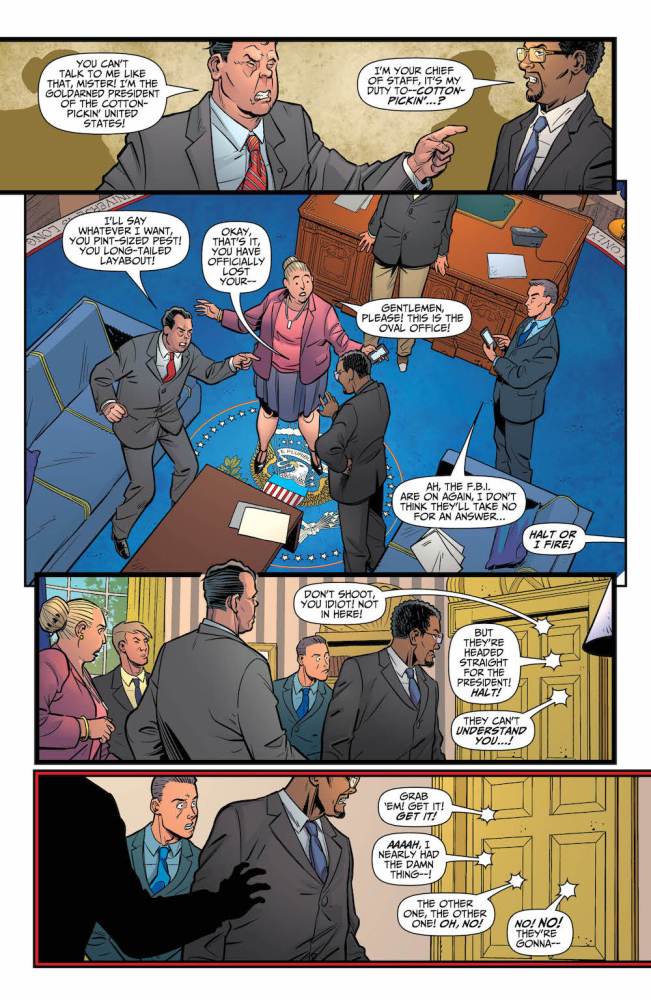
Corrina: It’s a fun concept, cartoons taking over real-world sensibilities and the havoc that this would ignite but it’s also a hard concept to carry through for more than an issue or two and this issue suffers from that, as the segments are interesting enough, especially those looking for cartoon easter eggs, but, as a story, it simply repeating the same elements over and over. The continued character growth between Dastardly & Muttley at least shows some story progression.
Batman: The Devastator #1 – Frank Tieri, James Tynion IV, Writers; Tony Daniel, Penciller; Danny Miki, Inker; Tomeu Morey, Colorist
Ray – 7/10
Corrina: So, Batman Doomsday Time
Ray: I was a bit surprised to see Tynion’s name on the credits for this issue, as it wasn’t originally announced with him as writer. The final of these Dark Knights specials (besides the much-hyped spotlight for the Batman who Laughs) brings us a Dark Knight designed specifically to stop Superman – in the form of the Doomsday virus. Every one of these specials focuses on one of Batman’s greatest fears and how it could wind up corrupting him, and this one is centered on his paranoia about Superman going rogue and needing to be stopped. The problem is, much like The Drowned, this one is sorely lacking in context. Over the course of this whole issue, we don’t know why Superman went evil in this world. We pick up in the middle of the story to find Batman injecting himself with the Doomsday virus to kill Superman, and from there the story’s off.
This issue does have some genuinely creepy moments. This Batman may have been the most well-intentioned of the lot – he wasn’t acting out of grief, but out of a genuine immediate crisis that he couldn’t see any other way to stop – but by the time he arrives on Earth Zero, he’s clearly deranged, and his segments with Lois as the Doomsday virus spreads over Metropolis. However, much like the Drowned, he almost feels like a supporting character in his own story. Lois Lane is really the lead here, as she struggles to keep her son safe as the city transforms horribly around her. This is essentially a zombie thriller at its core, which I’m not thrilled about – remember, the Doomsday Virus concept was a poorly received Lobdell retcon, and I’m surprised it’s still being used. This isn’t the worst of the Dark Knights specials, but it’s one of several that doesn’t quite establish its lead character as much as I would have liked.
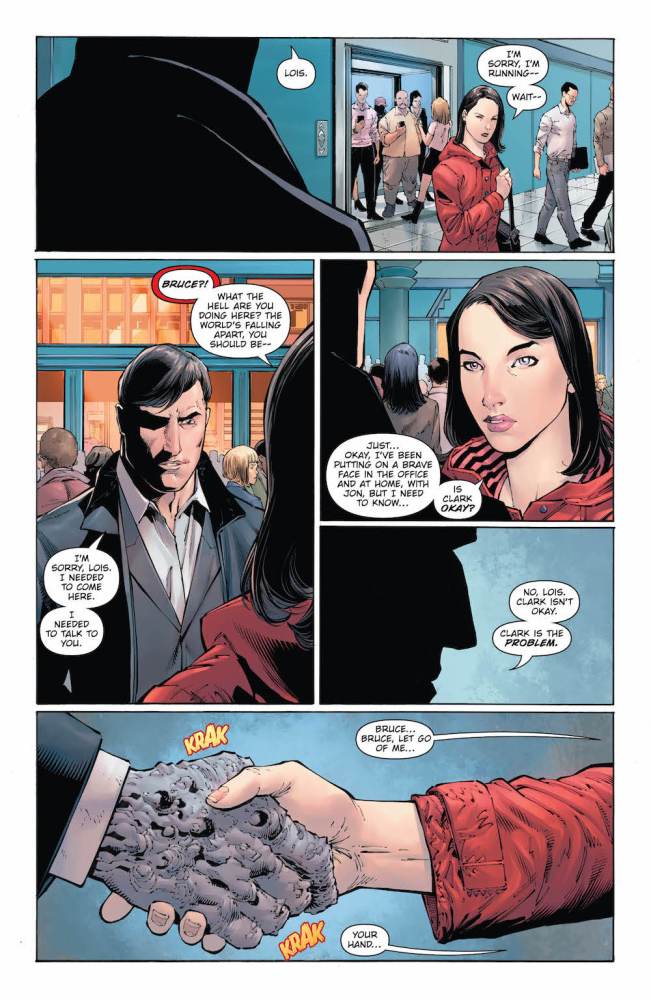
Corrina: We know why Superman went evil, right? Because it’s the dark universe and all things become evil there, no matter their good intentions. I guess that’s all the context DC feels we need in this event. And while “chaos and destruction are inevitable” might explain the motives behind all the Metal Batman, that does not mean those motives can be crafted into an interesting story.
All these stories read like the Marvel Dead-End “What Ifs?” that was all the rage for a while. What if Batman turned into Doomsday? What if Batman had Aquaman’s powers? What if the Joker became Batman or vice-versa? Whatever question that’s posed, the endings are all the same: everybody dies in that universe and evil Batman is still unhappy.
The Lois parts of the issue are interesting but this also will serve to sideline her for the rest of the event, as all other supporting characters have been sidelined. In the end, all that’s needed to be known from reading this issue is: there’s a Batman Doomsday and he’s turned Metropolis into beings like him. If you know that, there’s not a compelling reason to read the issue itself.
Cannot Be Saved: Ratings 5 or Less
Deadman #1 – Neal Adams, Writer/Artist
Ray – 2/10
Corrina: What the HECK?
Ray: With Neal Adams, you never know what you’re going to get, but you generally know it’s going to be weird. Batman: Odyssey was one of the strangest Batman comics ever told, and generally got weirder as it went along. His recent The Coming of the Supermen was slightly more coherent but still featured many of Adams’ frequent dialogue quirks. And now comes this miniseries, a focus on a lesser-known character – or is it? That’s the first thing about this Deadman miniseries – it’s not really a Deadman miniseries. It’s actually a sequel to Batman: Odyssey, picking up on direct plot threads from there and altering the ending. Deadman does appear, but he’s more just hopping back and forth between people, chasing his arch-nemesis The Hook.
The bulk of the issue involves Commissioner Gordon visiting a nuclear plant aboard, and then being knocked out by another Commissioner Gordon, who turns out to be Batman and needs to take his place to prevent nuclear sabotage. It’s a series of twists and turns, but they rarely make much sense and Deadman screaming in the background doesn’t help much. There are some reveals about Deadman’s family history, and the return of the main villain from Odyssey, but this strange act three of a comic that’s best known for having Batman take a nap on the floor is overall a mess. DC’s been doing so well with Rebirth, but outside of that branding, things are a bit more scattered. You have things like Raven or Black Lightning, which fit in neatly with the main line, and then you have oddballs like this. Oddballs aren’t inherently bad, but between the dialogue and incoherent plotting, this one is.
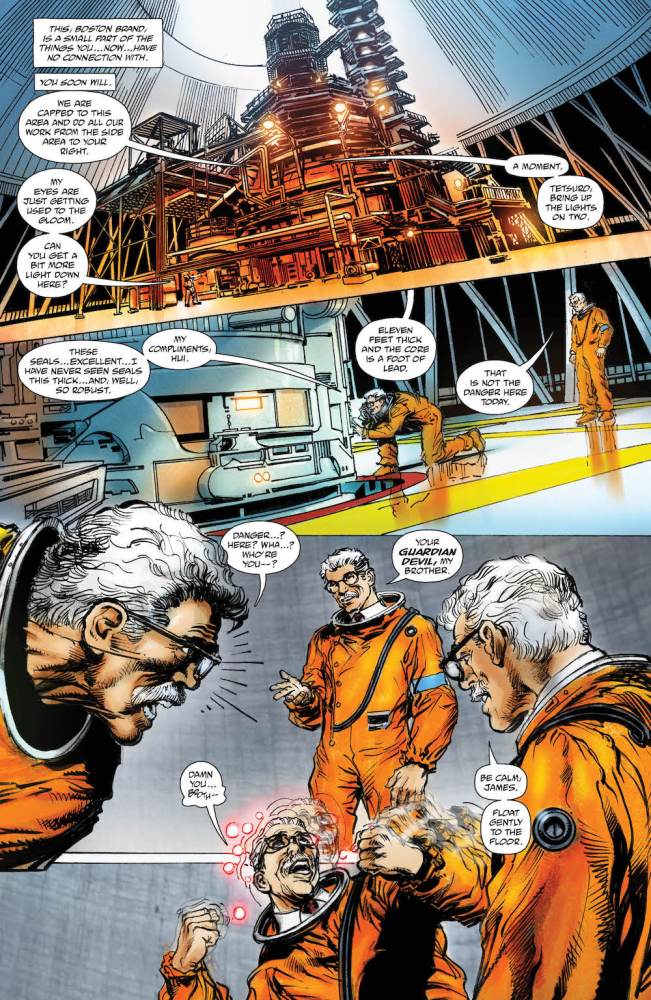
Corrina: Adams tends to have his own logic when telling stories, which can make them bizarrely fun (see: Batman riding a dinosaur), but, more often, it makes them incoherent. Why should Gordon be inspecting nuclear power plants? Is that a skill the good Commish acquired at night school, in between fighting corruption in Gotham? And that’s not even the worst logic issue in the story. Hard pass.
All images via DC Comics
Disclaimer: GeekDad received these comics for review.


